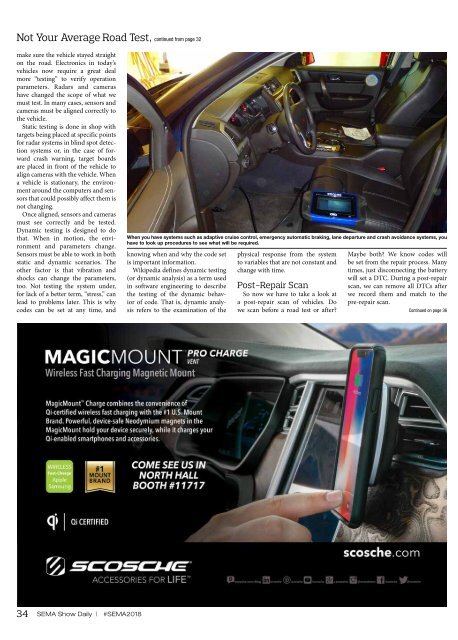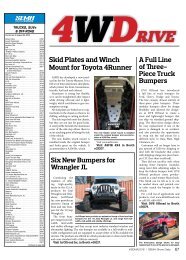Sema Show Daily 2018
You also want an ePaper? Increase the reach of your titles
YUMPU automatically turns print PDFs into web optimized ePapers that Google loves.
Not Your Average Road Test, continued from page 32<br />
make sure the vehicle stayed straight<br />
on the road. Electronics in today’s<br />
vehicles now require a great deal<br />
more “testing” to verify operation<br />
parameters. Radars and cameras<br />
have changed the scope of what we<br />
must test. In many cases, sensors and<br />
cameras must be aligned correctly to<br />
the vehicle.<br />
Static testing is done in shop with<br />
targets being placed at specific points<br />
for radar systems in blind spot detection<br />
systems or, in the case of forward<br />
crash warning, target boards<br />
are placed in front of the vehicle to<br />
align cameras with the vehicle. When<br />
a vehicle is stationary, the environment<br />
around the computers and sensors<br />
that could possibly affect them is<br />
not changing.<br />
Once aligned, sensors and cameras<br />
must see correctly and be tested.<br />
Dynamic testing is designed to do<br />
that. When in motion, the environment<br />
and parameters change.<br />
Sensors must be able to work in both<br />
static and dynamic scenarios. The<br />
other factor is that vibration and<br />
shocks can change the parameters,<br />
too. Not testing the system under,<br />
for lack of a better term, “stress,” can<br />
lead to problems later. This is why<br />
codes can be set at any time, and<br />
11SE_18BSSCOCHE1Pre 8/15/18 8:43 AM Page 1<br />
When you have systems such as adaptive cruise control, emergency automatic braking, lane departure and crash avoidance systems, you<br />
have to look up procedures to see what will be required.<br />
knowing when and why the code set<br />
is important information.<br />
Wikipedia defines dynamic testing<br />
(or dynamic analysis) as a term used<br />
in software engineering to describe<br />
the testing of the dynamic behavior<br />
of code. That is, dynamic analysis<br />
refers to the examination of the<br />
physical response from the system<br />
to variables that are not constant and<br />
change with time.<br />
Post-Repair Scan<br />
So now we have to take a look at<br />
a post-repair scan of vehicles. Do<br />
we scan before a road test or after?<br />
Maybe both? We know codes will<br />
be set from the repair process. Many<br />
times, just disconnecting the battery<br />
will set a DTC. During a post-repair<br />
scan, we can remove all DTCs after<br />
we record them and match to the<br />
pre-repair scan.<br />
Continued on page 36<br />
34 SEMA <strong>Show</strong> <strong>Daily</strong> | #SEMA<strong>2018</strong>
















